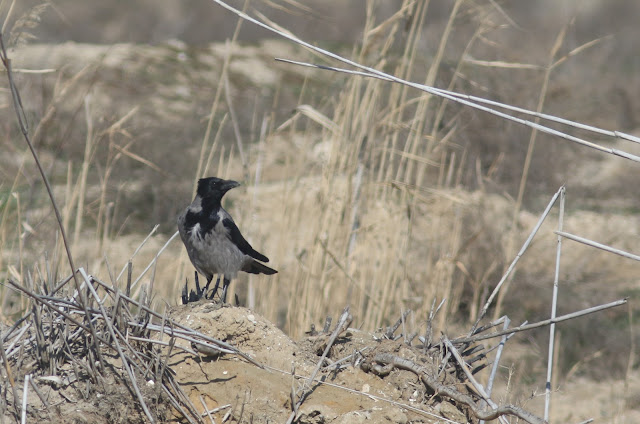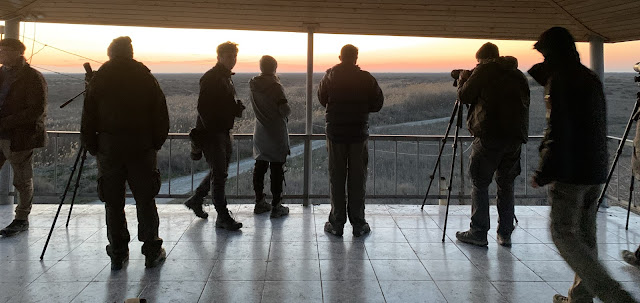Trip report including all our sightings from the park here.
A few photo highlights below.
Little Bustards (above and below)
The highlight of this whole trip was on 10th March at approximately 3pm when a flock of Little Bustards flew over the watch tower stretching from one end of the sky to the other taking 2 minutes to pass over head. We couldn't begin to know for sure how many birds were involved but we guessed anything between 50,000 to 100, 0000. As there are only 50,000 or so Little Bustards wintering in Azerbaijan these birds were presumably migrating from Iran. Without doubt the single best vis mig moment of my birding life. Absolutely mind blowing.
Isabelline Wheatears- on some days we counted up to 20 birds
There were hundreds of Calandra Larks in the park this trip but last year at the same time we didn't see any at all. Presumably a nomadic and irruptive bird in the park.
There were also good numbers of Turkestan Short-toed Lark this year too.
Isabelline Shrike- the sandy/buff underparts and buffy supercilium suggests Isabelline rather than Turkestan and it looks like an adult bird with a dark mask. The lack of barring on the underparts indicates a male (females typically have barring and also have a less well defined 'bandit' mask) and the bird was also singing which supports a male verdict. Adult males generally have a complete black mask that includes the lores too but this feature is variable.
Calandra Lark
Male (above) and female (below) Black Francolin
Caucasian 'Coutelli' Water Pipit .
Immature Dalmatian Pelican- we had a few Dalmatian and White Pelicans migrating over the park
2nd calendar year Imperial Eagle . We also had White-tailed and Great Spotted Eagles.
Curlew- there was talk about these being orientalis with the very long bills and contrasting white underwings
White-tailed Lapwings , photo not at Shirvan but at nearby salt pans but we had migrating White-tailed and Sociable Lapwings at Shirvan
2nd calendar year Hen Harrier (above) and Pallid Harrier (below)
Ruddy Shelducks- a characteristic species of the park, We counted over 700 coming into roost.
Marsh Harrier- up to 25 birds were frequenting the reed bed, a constant and delightful back drop to our stake out with displaying, fighting and plenty of vocalisations.
There were plenty of Penduline Tits this year some were flying around, occasionally at height calling
Corn Buntings
Hooded Crow
European Stonechat (?). We had a couple of Caspian Stonechats with typical Wheatear like tails and also a male that looked more like a Siberian Stonechat, with rich tones concentrated around the breast contrasting with paler underparts. However this bird showed warm saturated underparts more indicative of a European Stonechat, although it also had a distinctive pale and apparent unmarked rump. According to Ebird European Stonechat does occur in the region.
One of the 'large-billed' or 'Southern' Reed Buntings. Based on the pale underparts and thin necklace this is possibly Asian Reed Bunting (Emberiza schoeniclus pyrrhuloides) (Photo by Vincent Legrand)
Mountain Chiffchaff (Photo by Vincent Legrand).
White Wagtail, the extensive white in the greater coverts indicates Motacilla alba dukhunensis (Photo by Vincent Legrand)
Caspian Sea Wolf, Canis lupus campestris we had an incredible 12 different animals including a pack of 7. One of the highlights of the trip.
Golden Jackal, on one day we had a three canid day with Wolf, Golden Jackal and Red Fox (below)
Wild Boar (above and below) - several sightings included one group of 12 or so animals
Goitered Gazelles
We saw plenty of Jerboas on the drive back in the evening. This dead one was found near the watch tower. Presumably a William's Jerboa.
Lizard sp. Still working on this. There were several of these on one of the warmer days. Also had a Levantine Viper which was so aggressive I failed to get a photo of it before it went underground. There's 29 species of lizard in Az. Wiki list here (thanks Zulfu). Also snake species of Az here. Just heard back from Pierre-Andre that it's a Snake-eyed Lizard (bonus lifer!)
Spur-thighed Tortoise- they were common especially near the coast
Something in the Marsh Frog complex I presume
European Tree Frog Update 260323- Zulfu informs me that European Tree Frog doesn't occur in Az so it's either Eastern Tree Frog, orientalis or Middle East Tree Frog , savignyi
Winter Damselfly
Plant Net has suggested Field Marigold for these. Many were flowering particularly along the coast.
The stake out at the Watch Tower
The Mountain Chiffchaff twitch
Typical Steppe habitat of Shirvan











































No comments:
Post a Comment